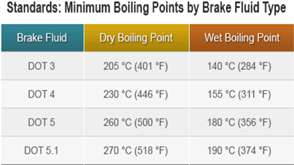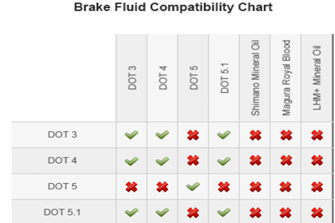What’s the consensus on which brake fluid to use on a completely clean new master, lines and cylinders? Internet search creates more questions than answers…
My experience with the Dot 5 fluid is it is OK if the car will be only driven on and off the trailer. It’s not any good for anything more. Dot 3 is what was used originally and it works great. It’s a fabulous paint remover too - so don’t spill any on painted surfaces.
I’ll disagree with Royce a bit on Dot5; the advantages are: doesn’t remove paint, and works reasonably well for classic cruising. It is also non-hydroscopic (it doesn’t soak up moisture). The disadvantages are: a bit less firm than Dot3 (but adequate), and a bitch to get air bubbles out if you shake the bottle.
If you are not going on the track or racking up the miles on a yearly basis, Dot5 works well.
I put dot5 in a 67 Shelby in 2008. Still no problems to this day and over 2000 miles. Brake pedal is undetectably different from dot3. I’ve done it in the last two restorations without issues. I chose it mostly because of the paint savings, but have never been disappointed with the results.
With Royce here, but it is situational. Do you want fluid that is a non-corrosive preservative, or fluid that will perform under pressure? If mine was a show car that is trailered and not used like a driver, Dot 5 would do fine. However, if water does get into your DOT 5 system it won’t be absorbed and will rust susceptible components in the system. My 69 is a driver that I take out to work and multiple times a week while dealing with all the “skilled” drivers on the road these days, so I’ll use DOT 3. Flush and refill on a schedule and I don’t think you will see longevity issues over DOT 5 either. DOT 5’s biggest complaint is a 'spongier feel" to the pedal on braking, which is my greatest aversion. When I want to stop, I want to stop.
So what about dot 4? Is it off the table? I don’t have a problem putting in dot 3 but will dot5 destroy a Bendix booster like 3 will if and when the m/c leaks? Or does anybody had that happen?
Never used Dot 4 so no opinion or experience. Why use something else when Dot 3 works great ?
Dot 3 it is! Thanks for the input…
A suggestion to all. Remove old fluid from master cyl (using a turkey baster) fill w/ new and completely bleed the entire system. The rear systems allow for 10 or less times cracking open the bleeder before a refill is needed.
The front system allows for 15 times before a refill is needed.
This should be done every start to the season, along with other fluids (like antifreeze w/ dist. water) to help save hundreds of $$ replacing parts.
Enjoy the summer!!
DOT 4. My son uses Motul 660 which is a full synthetic DOT 4 brake fluid. It has a high boil point and works great in his Foxbody Mustang that he tracks at times. Great pedal feel and it plan outperforms DOT 3 and regular DOT 4 fluids out there.
I used Dot 5 on a recent XY Falcon GT build with freshly built brake system. Dot 5 for all the reasons listed above - doesn’t eat paint, won’t rust out the booster if M/C leaks. I don’t notice any difference in pedal feel.
Cougar and Shelby are still Dot 4.
DOT 5 is silicone based and cannot be mixed with any other brake fluid. DOT 3, 4 and 5.1 will all work together. If you ever go to 5, you need to flush the system thoroughly of any other fluid. Race cars, 5…street cars 3,4,5.1.
My experience with brake fluids. I’ve used Dot 3, 4, 5 at different times. But after having a few mishaps with spilling or dripping the 3 & 4 while checking or adding fluids, I switched to Dot 5 silicone about 40+ years ago. (color me advanced maturity). I’ve got a 50’s, 60’s and 70’s Fords and never had a problem with it. Had a very slight pedal compression on my first car, but that went away after I bled it a couple more times. A little bit of the 3 fluid was hiding. My other cars I just put in in when I restored them and it’s been solid pedal from the beginning. Used it on road courses, never boiled it. Sure boiled the #3 fluid though, real memorable.
If you’ve ever been in the military, that’s all they use, the #5 purple juice. Just don’t mix with the 5.1, it is not silicone, it’s glycol based like 3 & 4. Brilliant numbering when they made that.
Also, do not use dot 5 in the newer anti-lock systems. No cars have it.
Main differences are the boiling points. See below:


The main reason ABS systems don’t use DOT 5 is because it would require separate validations for performance and durability. Those validations are expensive.